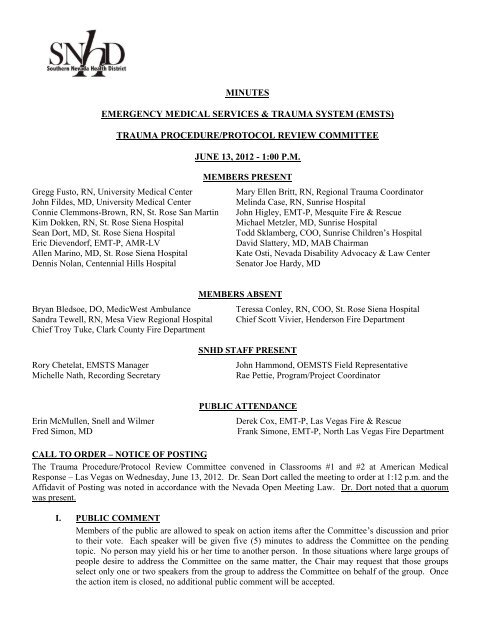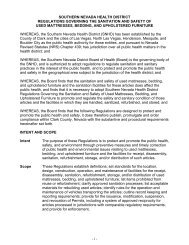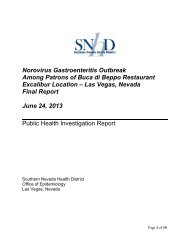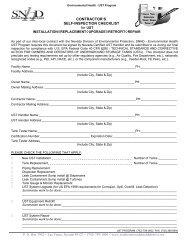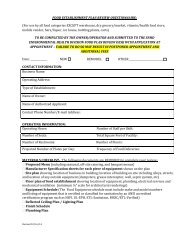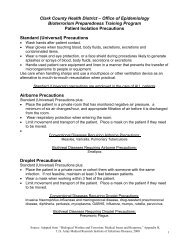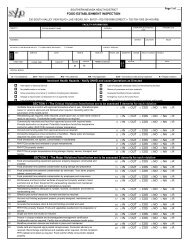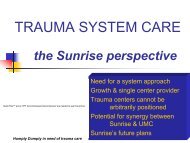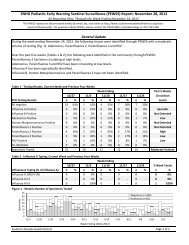Karla: Ok, we'll go ahead and call the meeting to order - Southern ...
Karla: Ok, we'll go ahead and call the meeting to order - Southern ...
Karla: Ok, we'll go ahead and call the meeting to order - Southern ...
Create successful ePaper yourself
Turn your PDF publications into a flip-book with our unique Google optimized e-Paper software.
MINUTESEMERGENCY MEDICAL SERVICES & TRAUMA SYSTEM (EMSTS)TRAUMA PROCEDURE/PROTOCOL REVIEW COMMITTEEJUNE 13, 2012 - 1:00 P.M.MEMBERS PRESENTGregg Fus<strong>to</strong>, RN, University Medical Center Mary Ellen Britt, RN, Regional Trauma Coordina<strong>to</strong>rJohn Fildes, MD, University Medical CenterMelinda Case, RN, Sunrise HospitalConnie Clemmons-Brown, RN, St. Rose San Martin John Higley, EMT-P, Mesquite Fire & RescueKim Dokken, RN, St. Rose Siena HospitalMichael Metzler, MD, Sunrise HospitalSean Dort, MD, St. Rose Siena HospitalTodd Sklamberg, COO, Sunrise Children’s HospitalEric Dievendorf, EMT-P, AMR-LVDavid Slattery, MD, MAB ChairmanAllen Marino, MD, St. Rose Siena HospitalKate Osti, Nevada Disability Advocacy & Law CenterDennis Nolan, Centennial Hills HospitalSena<strong>to</strong>r Joe Hardy, MDMEMBERS ABSENTBryan Bledsoe, DO, MedicWest AmbulanceTeressa Conley, RN, COO, St. Rose Siena HospitalS<strong>and</strong>ra Tewell, RN, Mesa View Regional Hospital Chief Scott Vivier, Henderson Fire DepartmentChief Troy Tuke, Clark County Fire DepartmentRory Chetelat, EMSTS ManagerMichelle Nath, Recording SecretarySNHD STAFF PRESENTJohn Hammond, OEMSTS Field RepresentativeRae Pettie, Program/Project Coordina<strong>to</strong>rErin McMullen, Snell <strong>and</strong> WilmerFred Simon, MDPUBLIC ATTENDANCEDerek Cox, EMT-P, Las Vegas Fire & RescueFrank Simone, EMT-P, North Las Vegas Fire DepartmentCALL TO ORDER – NOTICE OF POSTINGThe Trauma Procedure/Pro<strong>to</strong>col Review Committee convened in Classrooms #1 <strong>and</strong> #2 at American MedicalResponse – Las Vegas on Wednesday, June 13, 2012. Dr. Sean Dort <strong>call</strong>ed <strong>the</strong> <strong>meeting</strong> <strong>to</strong> <strong>order</strong> at 1:12 p.m. <strong>and</strong> <strong>the</strong>Affidavit of Posting was noted in accordance with <strong>the</strong> Nevada Open Meeting Law. Dr. Dort noted that a quorumwas present.I. PUBLIC COMMENTMembers of <strong>the</strong> public are allowed <strong>to</strong> speak on action items after <strong>the</strong> Committee’s discussion <strong>and</strong> prior<strong>to</strong> <strong>the</strong>ir vote. Each speaker will be given five (5) minutes <strong>to</strong> address <strong>the</strong> Committee on <strong>the</strong> pending<strong>to</strong>pic. No person may yield his or her time <strong>to</strong> ano<strong>the</strong>r person. In those situations where large groups ofpeople desire <strong>to</strong> address <strong>the</strong> Committee on <strong>the</strong> same matter, <strong>the</strong> Chair may request that those groupsselect only one or two speakers from <strong>the</strong> group <strong>to</strong> address <strong>the</strong> Committee on behalf of <strong>the</strong> group. Once<strong>the</strong> action item is closed, no additional public comment will be accepted.
Trauma Procedure/Pro<strong>to</strong>col Review Committee Meeting MinutesPage 2Dr. Dort asked if anyone wished <strong>to</strong> address <strong>the</strong> Committee. Seeing no one, he closed <strong>the</strong> PublicComment portion of <strong>the</strong> <strong>meeting</strong>.II.III.CONSENT AGENDAThe Consent Agenda consists of matters <strong>to</strong> be considered by <strong>the</strong> Trauma Procedure/Pro<strong>to</strong>col ReviewCommittee that can be enacted by one motion. Any item may be discussed separately per Committeemember request. Any exceptions <strong>to</strong> <strong>the</strong> Consent Agenda must be stated prior <strong>to</strong> approval.Approve Minutes: Trauma Procedure/Pro<strong>to</strong>col Review Committee Meeting: 4/18/2012REPORT/DISCUSSION/POSSIBLE ACTIONA. Review & Approval of Draft Trauma Procedure/Pro<strong>to</strong>col Review Committee (TPPRC) BylawsMary Ellen Britt reported that <strong>the</strong> draft TPPRC bylaws were approved at <strong>the</strong> last <strong>meeting</strong>, with <strong>the</strong>exception that <strong>the</strong> Health District would clarify <strong>the</strong> process for moving items from <strong>the</strong> TPPRC <strong>to</strong> <strong>the</strong>Regional Trauma Advisory Board (RTAB) <strong>and</strong> <strong>to</strong> <strong>the</strong> Medical Advisory Board (MAB). Sheexplained that <strong>the</strong> MAB was added in<strong>to</strong> <strong>the</strong> grouping <strong>to</strong> which <strong>the</strong> TPPRC will be providinginformation. Recommendations from <strong>the</strong> TPPRC will be reported <strong>to</strong> <strong>the</strong> RTAB, <strong>and</strong>recommendations from <strong>the</strong> RTAB related <strong>to</strong> <strong>the</strong> Clark County EMS System BLS/ILS/ALS pro<strong>to</strong>colswill be reported <strong>to</strong> <strong>the</strong> MAB for consideration <strong>and</strong> possible action. Ms. Britt added that <strong>the</strong> MABwas added <strong>to</strong> Article II for <strong>the</strong> same reasons. The remaining revisions were related <strong>to</strong> formatting,along with <strong>the</strong> addition of enabling each member <strong>to</strong> designate an alternate <strong>to</strong> serve in <strong>the</strong>ir placeshould <strong>the</strong>y be temporarily unable <strong>to</strong> perform <strong>the</strong> required duties.A motion was made <strong>to</strong> approve <strong>the</strong> revisions made <strong>to</strong> <strong>the</strong> TPPRC bylaws. The motion was seconded<strong>and</strong> passed unanimously by <strong>the</strong> Committee.B. Discussion of Draft Trauma Field Triage Criteria (TFTC) Pro<strong>to</strong>col1. Field Triage CriteriaMs. Britt related that one of <strong>the</strong> items referred <strong>to</strong> <strong>the</strong> TPPRC from <strong>the</strong> RTAB was <strong>to</strong> begin <strong>the</strong>review of <strong>the</strong> current TFTC pro<strong>to</strong>col, which is an EMS pro<strong>to</strong>col. She stated that staff created adraft by inserting <strong>the</strong> language from <strong>the</strong> new CDC Guidelines for Field Triage of InjuredPatients in<strong>to</strong> <strong>the</strong> existing pro<strong>to</strong>col <strong>to</strong> use as a starting point for discussion. She suggested <strong>the</strong>Committee begin by reading through <strong>the</strong> pro<strong>to</strong>col line by line.Dr. Metzler noted that <strong>the</strong> use of “” signs throughout <strong>the</strong> pro<strong>to</strong>col may cause confusion<strong>and</strong> that perhaps it should be spelled out. Dr. Fildes stated <strong>the</strong>re was discussion on that point by<strong>the</strong> national EMS leadership panel. For example, <strong>the</strong>y opted <strong>to</strong> change <strong>the</strong> verbiage “Glas<strong>go</strong>wComa Scale is < 14” <strong>to</strong> “≤13” because those with a score of 14 were being transported <strong>to</strong> traumacenters. Dr. Metzler stated that “13 or less” would be clearer than “≤13.” Rory stated that <strong>the</strong>rehaven’t been any issues related <strong>to</strong> <strong>the</strong> use of “” signs in <strong>the</strong> past. He agreed <strong>to</strong> take Dr.Metzler’s recommendation <strong>to</strong> <strong>the</strong> MAB for consideration.Dr. Dort asked whe<strong>the</strong>r <strong>the</strong> CDC guidelines have been adopted universally. Ms. Britt replied tha<strong>to</strong><strong>the</strong>r states are also in <strong>the</strong> process of reviewing <strong>the</strong> document <strong>and</strong> considering what action <strong>to</strong>take. The Committee agreed that <strong>the</strong> guidelines need <strong>to</strong> be adjusted <strong>to</strong> fit <strong>the</strong> needs of ClarkCounty’s EMS system. Dr. Slattery stated that recommendations from <strong>the</strong> RTAB will bepresented <strong>to</strong> <strong>the</strong> MAB for <strong>the</strong>ir consideration.Dr. Slattery expressed concern that elderly patients that have been injured are being seen at nontraumahospitals <strong>and</strong> later requiring transfer <strong>to</strong> a trauma center. He indicated <strong>the</strong> language inStep 4 did not seem strong enough <strong>and</strong> that <strong>the</strong> Board should consider moving elderly traumapatients fur<strong>the</strong>r up <strong>the</strong> triage scheme. He suggested using similar verbiage as stated in Step4(b)(1), “Children should be triaged preferentially <strong>to</strong> pediatric capable trauma centers,” <strong>to</strong>identify <strong>the</strong> at-risk elderly patients because of <strong>the</strong>ir pre-disposition for severe injury. Melinda
Trauma Procedure/Pro<strong>to</strong>col Review Committee Meeting MinutesPage 3Case stated that Sunrise is looking at this as a performance improvement issue. What <strong>the</strong>y arefinding is when <strong>the</strong>se patients are transported as a Step 4 consideration <strong>the</strong>y generally meet oneor more of <strong>the</strong> criteria in Step 1 or 2, or may have o<strong>the</strong>r special considerations, such as a his<strong>to</strong>ryof being on an anti-coagulant. Mr. Chetelat stated that analysis of hospital discharge data from<strong>the</strong> Center for Health Information Analysis showed some elderly patients with traumatic injurieswere transported <strong>to</strong> non-trauma hospitals. Dr. Dort continued <strong>the</strong> review of <strong>the</strong> Step 1 criteria.Dr. Marino made a motion <strong>to</strong> approve Step 1 as written. The motion was seconded.Dr. Metzler expressed concern regarding <strong>the</strong> draft language, “The pediatric patient MUST betransported <strong>to</strong> UMC, pediatric Level II center for <strong>the</strong> treatment of trauma.” He stated thatSunrise Hospital is in <strong>the</strong> process of making an application for designation as a pediatric Level IIcenter. He added that Sunrise currently has a very high capability of caring for pediatricpatients, but <strong>the</strong> draft language may deter <strong>the</strong> future transport of <strong>the</strong> pediatric patient population<strong>to</strong> Sunrise until after <strong>the</strong>y are designated as a Level II center for <strong>the</strong> treatment of trauma. Basedon <strong>the</strong> TFTC data, Mr. Fus<strong>to</strong> questioned if Sunrise would be able <strong>to</strong> meet <strong>the</strong> volumeperformance criteria. Dr. Fildes commented it is <strong>the</strong> responsibility of <strong>the</strong> American College ofSurgeons (ACS) <strong>to</strong> determine whe<strong>the</strong>r a trauma center has adequate volume. Ms. Case statedSunrise would make sure <strong>the</strong>y could meet <strong>the</strong> criteria before initiating <strong>the</strong> process. Dr. Metzlerquestioned how a new pediatric trauma center can come on board without <strong>the</strong> ability <strong>to</strong> havepatients transported while still in <strong>the</strong> application process. Dr. Marino replied it can beaccomplished through walk-in <strong>and</strong> out-of-state patient volume, similar <strong>to</strong> <strong>the</strong> stroke centerdestination process. Todd Sklamberg noted that Sunrise Hospital has invested over <strong>the</strong> years ina pediatric intensive care unit that is part of <strong>the</strong>ir trauma program <strong>and</strong> has all of <strong>the</strong> clinical <strong>and</strong>social services support <strong>to</strong> continue <strong>to</strong> provide for <strong>the</strong>se patients. The concern is how <strong>to</strong> take astep back <strong>and</strong> just rely on walk-ins or out-of-state volume in <strong>order</strong> <strong>to</strong> fulfill <strong>the</strong> volumeperformance criteria when clini<strong>call</strong>y <strong>the</strong> processes <strong>and</strong> physicians on staff are in place right now.Commenting on <strong>the</strong> pediatric Clark County Trauma Field Triage Criteria data, Dr. Fildesreported, “In 2011, 88% of <strong>the</strong> patients were Step 3 patients; <strong>and</strong> of <strong>the</strong> patients that were in Step1 <strong>and</strong> Step 2, several were delivered because <strong>the</strong>y were unstable <strong>and</strong> in proximity of thathospital, <strong>and</strong> that would continue. And o<strong>the</strong>r patients that weren’t directed by EMS but werebrought by private vehicle would still be delivered in that manner.” Dr. Metzler expressedconcern that <strong>the</strong> length of time for Sunrise <strong>to</strong> get full designation will be protracted.Dr. Marino withdrew his motion <strong>and</strong> made a new motion <strong>to</strong> approve Step 1 as written, with <strong>the</strong>exception that <strong>the</strong> last sentence read, “The pediatric patient must be transported <strong>to</strong> a designatedpediatric center for <strong>the</strong> treatment of trauma.” The motion was seconded by Dr. Slattery.Questions were raised about <strong>the</strong> process involved in Sunrise Hospital becoming designated as apediatric Level II center for <strong>the</strong> treatment of trauma. Ms. Britt outlined <strong>the</strong> process as follows:1) Sunrise submits an application for authorization <strong>to</strong> seek designation as a trauma center whichis considered for endorsement by <strong>the</strong> RTAB; 2) <strong>the</strong> RTAB recommendation regardingauthorization <strong>go</strong>es <strong>to</strong> <strong>the</strong> Board of Health (BOH) for approval; 3) Sunrise takes <strong>the</strong> approvalletter from <strong>the</strong> BOH <strong>to</strong> make application <strong>to</strong> <strong>the</strong> State Health Division for designation;4) arrangements for verification through <strong>the</strong> ACS is done concurrently; <strong>and</strong> 5) <strong>the</strong> final decisionfor full designation is made by <strong>the</strong> State Health Division. Ms. Britt explained that <strong>the</strong> term“designated” involves having successfully <strong>go</strong>ne through <strong>the</strong> entire process of authorization,verification <strong>and</strong> designation, pursuant <strong>to</strong> NAC 450B.780 <strong>to</strong> 450B.785 inclusive, in accordancewith <strong>the</strong> ACS trauma center classification scheme. She noted that NAC 450B.799 definespediatric center for <strong>the</strong> treatment of trauma as, “a facility that is designated by <strong>the</strong> administra<strong>to</strong>rof <strong>the</strong> Health Division pursuant <strong>to</strong> provisions of NAC 450B.780 <strong>to</strong> 450B.785 inclusive, <strong>to</strong>provide comprehensive surgical, medical <strong>and</strong> nursing care <strong>to</strong> persons who are less than 15 yearsof age.”Dr. Marino withdrew his motion.
Trauma Procedure/Pro<strong>to</strong>col Review Committee Meeting MinutesPage 6III.IV.INFORMATIONAL ITEMS/DISCUSSION ONLYThe Committee agreed <strong>to</strong> meet again on August 15 th at 1:00 p.m. Mr. Chetelat stated <strong>the</strong> location willbe announced at a later date. Ms. Britt thanked Eric Dievendorf <strong>and</strong> American Medical Response foroffering <strong>the</strong>ir building as a venue for <strong>meeting</strong>s. Ms. Britt also announced <strong>the</strong> first TraumaRehabilitation Committee <strong>meeting</strong> will be held on June 20 th at 8:00 am.PUBLIC COMMENTMembers of <strong>the</strong> public are allowed <strong>to</strong> speak on action items after <strong>the</strong> Committee’s discussion <strong>and</strong> prior<strong>to</strong> <strong>the</strong>ir vote. Each speaker will be given five (5) minutes <strong>to</strong> address <strong>the</strong> Committee on <strong>the</strong> pending<strong>to</strong>pic. No person may yield his or her time <strong>to</strong> ano<strong>the</strong>r person. In those situations where large groups ofpeople desire <strong>to</strong> address <strong>the</strong> Committee on <strong>the</strong> same matter, <strong>the</strong> Chair may request that those groupsselect only one or two speakers from <strong>the</strong> group <strong>to</strong> address <strong>the</strong> Committee on behalf of <strong>the</strong> group. Once<strong>the</strong> action item is closed, no additional public comment will be accepted.Dr. Dort asked if anyone wished <strong>to</strong> address <strong>the</strong> Committee. Seeing no one, he closed <strong>the</strong> PublicComment portion of <strong>the</strong> <strong>meeting</strong>.V. ADJOURNMENTAs <strong>the</strong>re was no fur<strong>the</strong>r business on <strong>the</strong> agenda, Dr. Dort <strong>call</strong>ed for a motion <strong>to</strong> adjourn. The motionwas seconded <strong>and</strong> passed unanimously <strong>to</strong> adjourn at 2:26 p.m.


